PEP《英语》四(上)Unit 5 Dinner’s ready ALet’s talk
文 |周淑敏
教学过程
Step 1. Warming-up
1.Greeting
T: Class begins. Good morning,everyone. Are you ready for the class?
Ss: Yes, ready!
2.Let’s sing
T: Today we are going to learn “Unit 5 Dinner’s ready A Let’s talk”. First, let’s enjoy a song together.
3.Free talk
T: Wow! We see so much food in the song! What are they? Let’s say together.
T: My mouth is watering when I see the food. I’d like some... Mm, yummy yummy. Boys and girls, what about you? What would you like?
S1-3: I’d like some...(and...)
T: OK. Here you are. 教师将食物贴纸给学生。
And pay attention, “I’d like...”is the short form for“I would like...”
教师将答句“I’d like some...”板贴在黑板上。
设计意图:本课教学内容是PEP《英语》四(上)Unit 5 Dinner’s ready A Let’s talk。学生在三年级已经学了一些表示食物的名词以及用“I’d like some...”来表达自己想吃什么。教师利用与主题相契合的歌曲进行热身,并引导学生看图谈论自己想吃的食物,不仅巩固了旧知,也让学生初步感知本课重点句型“What would you like? I’d like some...”。
Step 2. Presentation and practice
1.Leading in
T: Now, look at this picture.(引导学生看图中的月亮)It’s in the evening.
Look, who are they?
Ss: Mike, Mum and Dad.
T: Yes, where are they?
Ss: In the kitchen.
T: Yes. And they are talking. What are they talking about?Let’s listen and choose.
Ss: Dinner.
T: Great! They are talking about the food for dinner.
And look, what do we usually have for dinner? A or B?
Ss: Yes, so “dinner”means“晚餐(正餐)”. In the evening,we have dinner.
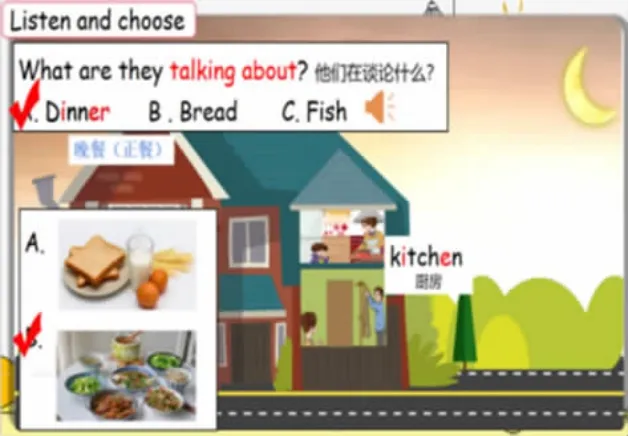
设计意图:让学生在情境中理解新词dinner 的含义,并整体感知对话的主要内容。
2.Text learning
(1)Scene 1: What would Mike like for dinner?
Activity 1: Listen and fill
T: So they are talking about the dinner. And Mike wanna know “What’s for dinner?”And mom asks...?
教师播放音频,学生说出问句。
Ss: What would you like?
教师拿出板贴带读,请小组及个人读,纠正发音。
Activity 2: Watch and tick
T: So, what would Mike like? Let’s watch and tick.
学生观看视频回答。
Ss: He’d like some soup and bread.
教师引导学生看图理解soup的意思并带读。

Activity 3: Read, check and act
①T: Now, let’s read and check.
学生读出关键词,教师在课件上圈出soup and bread。
②T: Great!Let’s listen and imitate.
教师播放音频,学生逐句跟读录音。
③T: Now, I’ll be Mike.And you’ll be Mom, OK?
分角色表演,教师扮演Mike,学生扮演妈妈。
最后引导学生思考,妈妈会怎么样回应,说出“OK./ Please wait.”。

T: So Mom cooks and cooks.(播放开门音效)Oh, listen!Who’s coming?
Ss: Dad.
设计意图:本课对话语篇的三个场景属于不同的话轮,因此在整体感知对话大意后,教师分场景呈现教学。在场景一中,首先,教师引导学生猜测妈妈在Mike 询问晚餐吃什么后,可能会问Mike 什么问题,培养学生的问题意识,使学生认识到“What would you like?”的语义及语用情景,即征求用餐意见。接着,通过视频、图文让学生获取关键信息。最后,通过听音模仿和角色扮演,让学生在情境中巩固新知,促进语言的巩固和内化。另外,教师选择表演起来更有发挥空间的角色Mike,加入了细节表演(如Mike刚刚回到家放下书包,走向厨房),为学生最后的role play 作示范,也增添了表演的趣味性。
(2)Scene 2: What would Dad like for dinner?
Activity 1: Look and say
T: Dad is back from work.What will mum say?
学生先尝试说,播放音频验证学生的猜测,呈现句子“What would you like for dinner?”,教师拿出板贴带读,之后贴在黑板上。
Activity 2: Watch and circle
T: What would Dad like for dinner? Let’s watch and circle.
Ss: Dad would like some fish and vegetables.
教师引导学生看图理解vegetables 的意思,并按音节带读。
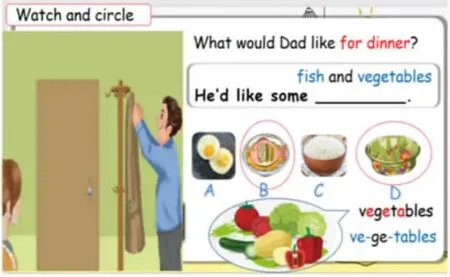
Activity 3: Read, check and act
先出示文本,学生说出关键词,教师在课件上圈出fish and vegetables;接着逐句跟读录音;最后分角色表演,教师扮演爸爸,学生演妈妈,同样引导学生说出“OK./Please wait.”。
(3)Scene 3: Dinner’s ready
Activity 1: Look and say
T: So Mom cooks and cooks again. 教师边做动作边将四种食物的词卡贴于黑板,引导学生说出“Now, the bread is ready. The soup is ready.”。
T: So dinner’s ready!
What will Mike and Dad say?
Ss: Thank you.
T: Yes, they can also say“Thanks”!
设计意图:通过板书总结,引出场景三中的“Dinner’s ready!”和“Thanks!”,让学生在情境中习得语言。
Activity 2: Look, think and say
T: So, look! What’s for dinner today?(指着课件)
Ss: Bread, fish, vegetables,soup, and...
T: Oh, what’s this?
Ss: Bone.
T: Yes. And it’s for the...?Puppy!
And we know, Mike would like some... Dad would like some... Oh, how about mom?Let’s be Mike and ask together.
Ss: Mom, mom, what would you like?
T: Who can be mom and guess?
Ss: I’d like some...
T: Wow! Good guesses.
根据学生的回答作反馈:
若学生的回答是当日晚餐中有的:Mom would like some...,too. Wonderful!They can enjoy the dinner together.
若学生的回答是当日晚餐中没有的:Ah oh, but no... for mom today. Maybe she can cook tomorrow.
T: So you see, mom cooks what Mike and dad would like,whatagreatmom! And remember, we should care about each other.

设计意图:通过情境的补白,补充了小狗这一特殊家庭成员的用餐情境,使对话更丰富、生动;通过续编对话,猜测妈妈想要吃什么,使学生不仅深度感知了文本,也在潜移默化中体会了妈妈对家人的关怀和关爱,进而过渡到“We should care about each other.”,升华了主题。
Activity 3: Read and act
分角色表演,教师用道具扮演Mom,三大组学生分别饰演Mike、Dad 和Little puppy。
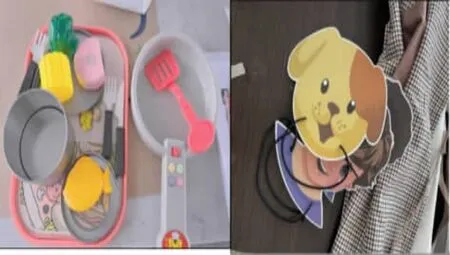
设计意图:教师在表演时,充分利用道具,演出细节,营造真实的氛围,同时运用拓展补充的语言:The bread is ready. The... is ready... Dinner is ready! 并引导学生在表演时加入上一环节生成的补白,为后续的role play 环节做了很好的示范,尤其为评价标准中的imagination 做了铺垫,给学有余力的学生提供了更多的学思空间。
3.Enjoy and imitate the story
教师播放完整视频,学生再次整体感知。
学生模仿视频中的语音语调。
4.Role play
T: Now, let’s act.
学生选择一至三个场景进行表演,表演结束后,观众根据场景数、正确度、流利度、表演的生动性及是否有个性化的创编进行评价,看哪个小组获得的星星最多。

设计意图:表演环节设计了不同的层次,学生可根据小组成员的实际情况选择相应的场景,让每个学生都有机会和信心参与进来;四个维度评价标准,对表演者起到了很好的引导作用,也促使观众更加认真地倾听、观看,并有理有据地进行评价。
Step 3. Consolidate and practice
1.Leading in
T: Boys and girls. You really did a good job. Here is a video for you. What’s the video about?
Ss: Picnic.
T: Yes. Do you like picnic?Here is the good news from our head teacher.
T: Wow!We will go on a picnic this Friday! But before that, we need to do a survey and make a food list.

设计意图:教师通过自制的picnic 短视频,在轻松愉悦的氛围中引出迁移创新活动——为学校周五的野餐活动制定菜单,通过调查和汇报完成班级的食物清单。
2.Interview
T: Look, this is the menu.We need to interview first.
教师播放学生采访的示范视频,并进一步通过课件的图文呈现。
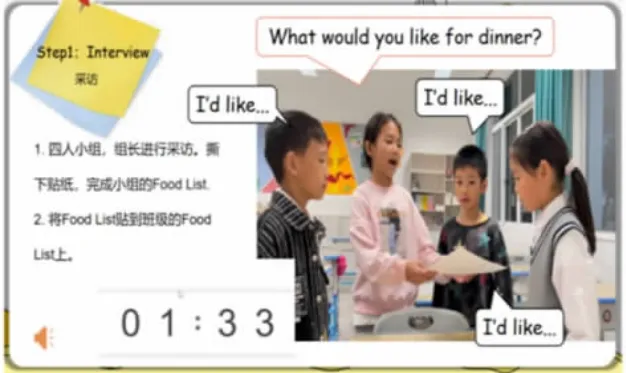
T: So, work in 4, ask and answer, and finish your food list.Clear?
You have 1.5 minutes.Ready? Go!
设计意图:通过课前拍摄的示范视频和简要的图文介绍,使学生很快领会本次活动的要领和操作步骤。
3.Make a report
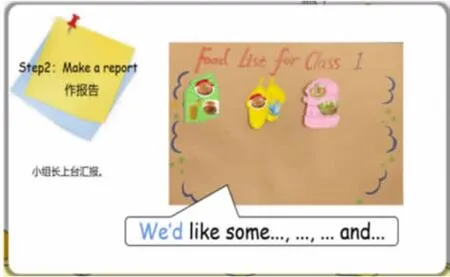
Group leaders: We’d like...
组长汇报完后,将本组的食物清单贴在班级的清单上进行汇总(详见板书设计)。
设计意图:通过真实的语用情境,让学生在活动中内化知识,完成对知识的再创造和迁移运用,学会用英语做事。
附:板书设计


